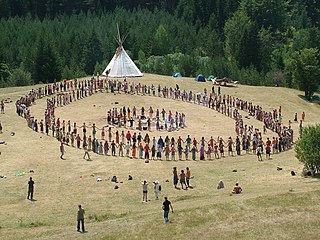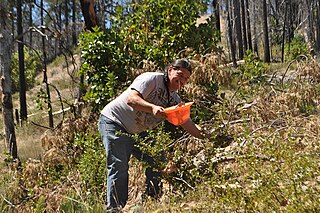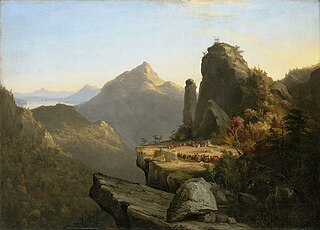Related Research Articles

The Hopi are Native Americans who primarily live in northeastern Arizona. The majority are enrolled in the Hopi Tribe of Arizona and live on the Hopi Reservation in northeastern Arizona; however, some Hopi people are enrolled in the Colorado River Indian Tribes of the Colorado River Indian Reservation at the border of Arizona and California.

The Hopi maintain a complex religious and mythological tradition stretching back over centuries. However, it is difficult to definitively state what all Hopis as a group believe. Like the oral traditions of many other societies, Hopi mythology is not always told consistently and each Hopi mesa, or even each village, may have its own version of a particular story, but "in essence the variants of the Hopi myth bear marked similarity to one another." It is also not clear that the stories told to non-Hopis, such as anthropologists and ethnographers, represent genuine Hopi beliefs or are merely stories told to the curious while keeping safe the more sacred Hopi teachings. As folklorist Harold Courlander states, "there is a Hopi reticence about discussing matters that could be considered ritual secrets or religion-oriented traditions."
Rainbow Warrior(s), rainbow warrior(s), or Warriors of the Rainbow may refer to

The Rainbow Family of Living Light is a counter-culture, in existence since approximately 1970. It is a loose affiliation of individuals, some nomadic, generally asserting that it has no leader. They put on yearly, primitive camping events on public land known as Rainbow Gatherings.

The Maidu are a Native American people of northern California. They reside in the central Sierra Nevada, in the watershed area of the Feather and American Rivers and in Humbug Valley. In Maiduan languages, maidu means "man".

Rainbow Gatherings are temporary, loosely knit communities of people, who congregate in remote forests around the world for one or more weeks at a time with the stated intention of living a shared ideology of peace, harmony, freedom, and respect. In the original invitation, spread throughout the United States in 1971, the "Rainbow Family Tribe" referred to themselves as "brothers & sisters, children of God", "Families of life on Earth", "Friends of Nature & of all People" and "Children of Humankind". All races, nations, politicians, etc. were invited in the desire that there could be peace among all people. The goal was to create what they believed was a more satisfying culture — free from consumerism, capitalism, and mass media — one that would be non-hierarchical, that would further world peace, and serve as a model for reforms to mainstream society. However, the values actually exhibited by the group have at times varied quite a bit from this ideal, with recent decades showing increasing levels of crime at the events, and some organizers stating the core principles have been modified, and become more mainstream, in an effort to attract more people.

CocoRosie is an American musical group formed in 2003 by sisters Sierra Rose "Rosie" and Bianca Leilani "Coco" Casady. The group's music has been described as folktronica, freak folk and "New Weird America", and incorporates elements of pop, blues, opera, electronica, and hip hop. The group has released seven studio albums, La Maison de Mon Rêve (2004), Noah's Ark (2005), The Adventures of Ghosthorse and Stillborn (2007), Grey Oceans (2010), Tales of a GrassWidow (2013), Heartache City (2015), and Put the Shine On (2020), and two EPs, Beautiful Boyz (2004) and Coconuts, Plenty of Junk Food (2009). They released their sixth album Heartache City on their own record label, Lost Girl Records.

The Karuk people are an indigenous people of California, and the Karuk Tribe is one of the largest tribes in California. Karuks are also enrolled in two other federally recognized tribes, the Cher-Ae Heights Indian Community of the Trinidad Rancheria and the Quartz Valley Indian Community.

The sinking of Rainbow Warrior, codenamed Opération Satanique, was a state terrorism bombing operation by the "action" branch of the French foreign intelligence agency, the Directorate-General for External Security (DGSE), carried out on 10 July 1985. During the operation, two operatives sank the flagship of the Greenpeace fleet, Rainbow Warrior, at the Port of Auckland on her way to a protest against a planned French nuclear test in Moruroa. Fernando Pereira, a photographer, drowned on the sinking ship.

Dan Namingha is a Hopi painter and sculptor. He is Dextra Quotskuyva's son, and a great-great-grandson of Nampeyo. He is a member of the Hopi-Tewa member of the Hopi Tribe. He lives in Santa Fe, New Mexico.

Navajo Mountain is a peak in San Juan County, Utah, with its southern flank extending into Coconino County, Arizona, in the United States. It holds an important place in the traditions of three local Native American tribes. The summit is the highest point on the Navajo Nation.

The Adventures of Ghosthorse and Stillborn is the third studio album by American musical group CocoRosie, released by Touch and Go Records on April 10, 2007.

Fred Kabotie was a celebrated Hopi painter, silversmith, illustrator, potter, author, curator and educator. His native name in the Hopi language is Naqavoy'ma which translates to Day After Day.

Rainbow Warrior was a Greenpeace ship involved in campaigns against whaling, seal hunting, nuclear testing and nuclear waste dumping during the late 1970s and early 1980s. The Direction Générale de la Sécurité Extérieure bombed Rainbow Warrior in the Port of Auckland, New Zealand on 10 July 1985, sinking the ship and killing photographer Fernando Pereira.
Michael Bailey, described as "one of the foremost eco-warriors of our times" according to Rex Weyler, is a founding member of Greenpeace, along with Paul Watson, Patrick Moore, David McTaggart and others. He supervised the original Greenpeace flagship, Rainbow Warrior.

The portrayal of Indigenous people of the Americas in popular culture has oscillated between the fascination with the noble savage who lives in harmony with nature, and the stereotype of the uncivilized Red Indian of the traditional Western genre. The common depiction of American Indians and their relationship with European colonists has however changed over time.

Invented traditions are cultural practices that are presented or perceived as traditional, arising from the people starting in the distant past, but which are relatively recent and often even consciously invented by identifiable historical actors. The concept was highlighted in the 1983 book The Invention of Tradition, edited by Eric Hobsbawm and Terence Ranger. Hobsbawm's introduction argues that many "traditions" which "appear or claim to be old are often quite recent in origin and sometimes invented." This "invention" is distinguished from "starting" or "initiating" a tradition that does not then claim to be old. The phenomenon is particularly clear in the modern development of the nation and of nationalism, creating a national identity promoting national unity, and legitimising certain institutions or cultural practices.

Polingaysi Qöyawayma, also known as Elizabeth Q. White, was a Hopi educator, writer, and potter.

Elizabeth Willis DeHuff (1886–1983) was an American painter, teacher, playwright, and children's book writer. She was an important contributor to the development of Native American easel painting in the 1920s and 1930s. DeHuff is also a children's book author who writes predominantly utilizing Native American folklore and themes. Among these books are Blue-Wings-Flying and TayTay's Tales. In writing these children's books, and other works by her like Kaw-eh and Say the Bells of Old Missions: Legends of Old New Mexico Churches that are not necessarily children's books, DeHuff is instrumental in documenting Native American folklore and providing authenticity in the telling of it. Overall, she wrote 65 works in 118 publications. These other works included non children's books and periodical articles Native American, Hispanic, and New Mexico subjects.
References
- 1 2 3 4 "Interview with Michael Niman". On The Road With John Tarleton. July 1999.
The roots of that myth go back to a book called Warriors of the Rainbow. It was basically an evangelical Christian tract which was published in 1962. If anything, it was an attack on Native culture. It was an attempt to evangelize within the Native American community.
- ↑ "About Naturegraph". Naturegraph Publishers, Inc. Archived from the original on 14 July 2011.
- 1 2 Niman, Michael (1997). People of the Rainbow: Nomadic Utopia . University of Tennessee Press. pp. 134–137. ISBN 978-0870499890.
- 1 2 Morton, Chris and Thomas, Ceri Louise (1998) The Mystery of the Crystal Skulls: A Real Life Detective Story of the Ancient World. Vermont, Bear & Company ISBN 978-1879181540.
- ↑ Brown, Michael (1989). The Greenpeace Story . Dorling Kindersley. pp. 12–13. ISBN 978-1879431027.
- ↑ "Rainbow Warrior I". Greenpeace. Archived from the original on 15 October 2011.
- 1 2 Estes, Nick; et al. (14 July 2015). "Protect He Sapa, Stop Cultural Exploitation". Indian Country Today Media Network. Archived from the original on 2016-03-03. Retrieved 2017-11-29.
- ↑ "Weirdly Beautiful Creations". The F Word. 17 June 2013. Retrieved 2023-01-06.
- ↑ "Tales of a Grasswidow". Pitchfork. Retrieved 2023-01-06.
- ↑ "CocoRosie Bring Freak Folk From the Future". Vulture.com. 19 October 2007. Retrieved 2023-01-06.